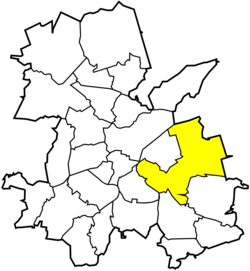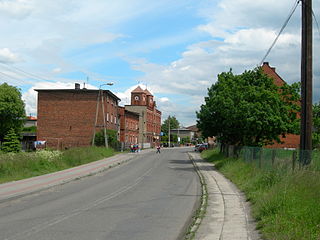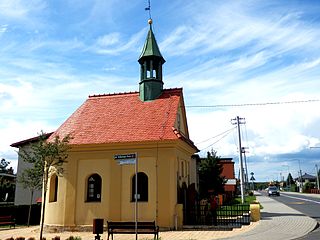| Ligota-Ligocka Kuźnia | |
|---|---|
| Rybnik District | |
Saint Lawrance church | |
 Location of Ligota-Ligocka Kuźnia within Rybnik | |
| Coordinates: 50°05′25″N18°35′49″E / 50.090251°N 18.596852°E Coordinates: 50°05′25″N18°35′49″E / 50.090251°N 18.596852°E | |
| Country | |
| Voivodeship | Silesian |
| County/City | Rybnik |
| Population (2013) | |
| • Total | 3,900 |
| Time zone | CET (UTC+1) |
| • Summer (DST) | CEST (UTC+2) |
| Area code(s) | (+48) 032 |
Ligota-Ligocka Kuźnia is a district of Rybnik, Silesian Voivodeship, southern Poland. On December 31, 2013 it had 3,900 inhabitants. [1]
In the Polish system of local administration, a dzielnica is an administrative subdivision or quarter of a city or town. A dzielnica may have its own elected council, and those of Warsaw each have their own mayor (burmistrz). Like the osiedle and sołectwo, a dzielnica is an auxiliary unit of a gmina. These units are created by decision of the gmina council, and do not have legal personality in their own right.

Rybnik(

Silesian Voivodeship, or Silesia Province, German: Woiwodschaft Schlesien, Czech: Slezské vojvodství) is a voivodeship, or province, in southern Poland, centered on the historic region known as Upper Silesia, with Katowice serving as its capital.
The district encompasses three historical settlements:
- Ligota (German : Ellguth),
- Ligocka Kuźnia,
- Raszowiec;

German is a West Germanic language that is mainly spoken in Central Europe. It is the most widely spoken and official or co-official language in Germany, Austria, Switzerland, South Tyrol (Italy), the German-speaking Community of Belgium, and Liechtenstein. It is also one of the three official languages of Luxembourg and a co-official language in the Opole Voivodeship in Poland. The languages which are most similar to German are the other members of the West Germanic language branch: Afrikaans, Dutch, English, the Frisian languages, Low German/Low Saxon, Luxembourgish, and Yiddish. There are also strong similarities in vocabulary with Danish, Norwegian and Swedish, although those belong to the North Germanic group. German is the second most widely spoken Germanic language, after English.
Ligota is a common name for villages in Western Poland. The word refers to the medieval custom of village founders being exempt from paying duties to their lords for a period of 5-8 years. In 1740 a small steel mill, called kuźnia (a smithy), was established here. Around it evolved Ligocka Kuźnia. It was modernised in years 1821-1822, but ceased to function in the late 19th century. Raszowiec was first mentioned in 1788. It had, however, always constituted an administrative part of Ligota, even though it belonged to the parish in Boguszowice. [1]

A forge is a type of hearth used for heating metals, or the workplace (smithy) where such a hearth is located. The forge is used by the smith to heat a piece of metal to a temperature where it becomes easier to shape by forging, or to the point where work hardening no longer occurs. The metal is transported to and from the forge using tongs, which are also used to hold the workpiece on the smithy's anvil while the smith works it with a hammer. Sometimes, such as when hardening steel or cooling the work so that it may be handled with bare hands, the workpiece is transported to the slack tub, which rapidly cools the workpiece in a large body of water. However, depending on the metal type, it may require an oil quench or a salt brine instead; many metals require more than plain water hardening. The slack tub also provides water to control the fire in the forge.

Boguszowice Stare is a district of Rybnik, Silesian Voivodeship, southern Poland. In the late 2013 it had about 7,700 inhabitants.
After World War I in the Upper Silesia plebiscite 1406 out of 2,195 voters in Ligota voted in favour of joining Poland, against 784 opting for staying in Germany. [2] In 1922 it became a part of Silesian Voivodeship, Second Polish Republic. Ligota (including Ligocka Kuźnia and Raszowiec) was absorbed by Rybnik in 1926. [1]

World War I, also known as the First World War or the Great War, was a global war originating in Europe that lasted from 28 July 1914 to 11 November 1918. Contemporaneously described as "the war to end all wars", it led to the mobilisation of more than 70 million military personnel, including 60 million Europeans, making it one of the largest wars in history. It is also one of the deadliest conflicts in history, with an estimated nine million combatants and seven million civilian deaths as a direct result of the war, while resulting genocides and the 1918 influenza pandemic caused another 50 to 100 million deaths worldwide.

The Upper Silesia plebiscite was a plebiscite mandated by the Versailles Treaty and carried out on 20 March 1921 to determine a section of the border between Weimar Germany and Poland. The region was ethnically mixed with both Germans and Poles; according to prewar statistics, ethnic Poles formed 60 percent of the population. Under the previous rule by the German Empire, Poles claimed they had faced discrimination, making them effectively second class citizens. The period of the plebiscite campaign and inter-Allied occupation was marked by violence. There were three Polish uprisings, and German volunteer paramilitary units came to the region as well.

The Silesian Voivodeship was an autonomous province (voivodeship) of the interwar Second Polish Republic. It became part of the newly reborn Poland as a result of the 1921 Upper Silesia plebiscite, the Geneva Conventions, three Upper Silesian Uprisings, and the eventual partition of Upper Silesia between Poland, Germany and Czechoslovakia. The capital of the voivodeship was Katowice.


















